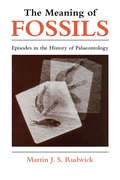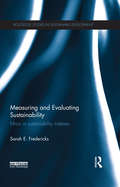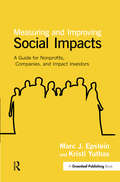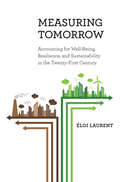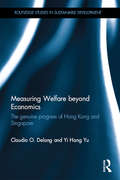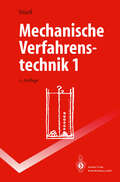- Table View
- List View
Meadows (British Wildlife Collection)
by George PeterkenMeadows, the second volume of a major new series of books on British natural history, provides one of the most wide-ranging and eloquent treatments of this most quintessential British habitat. Yet the flower-rich hay meadows that have inspired writers and artists for hundreds of years have almost disappeared from our countryside. In this exceptional work, George Peterken, one of our most respected ecologists, brings together years of research and discovery from his travels across Britain and Europe, as well as an understanding borne out of caring for his own meadows, to produce a book that will put this often misunderstood habitat back in the public's eye. Filled with beautiful images of meadows and their denizens, this is a book everyone with an interest in this iconic habitat will want to own.
Meadows (British Wildlife Collection)
by George PeterkenMeadows, the second volume of a major new series of books on British natural history, provides one of the most wide-ranging and eloquent treatments of this most quintessential British habitat. Yet the flower-rich hay meadows that have inspired writers and artists for hundreds of years have almost disappeared from our countryside. In this exceptional work, George Peterken, one of our most respected ecologists, brings together years of research and discovery from his travels across Britain and Europe, as well as an understanding borne out of caring for his own meadows, to produce a book that will put this often misunderstood habitat back in the public's eye. Filled with beautiful images of meadows and their denizens, this is a book everyone with an interest in this iconic habitat will want to own.
The Meaning of Fossils: Episodes in the History of Palaeontology
by Martin J. Rudwick"It is not often that a work can literally rewrite a person's view of a subject. And this is exactly what Rudwick's book should do for many paleontologists' view of the history of their own field."—Stephen J. Gould, Paleobotany and Palynology "Rudwick has not merely written the first book-length history of palaeontology in the English language; he has written a very intelligent one. . . . His accounts of sources are rounded and organic: he treats the structure of arguments as Cuvier handled fossil bones."—Roy S. Porter, History of Science
The Meaning of Fossils: Episodes in the History of Palaeontology
by Martin J. Rudwick"It is not often that a work can literally rewrite a person's view of a subject. And this is exactly what Rudwick's book should do for many paleontologists' view of the history of their own field."—Stephen J. Gould, Paleobotany and Palynology "Rudwick has not merely written the first book-length history of palaeontology in the English language; he has written a very intelligent one. . . . His accounts of sources are rounded and organic: he treats the structure of arguments as Cuvier handled fossil bones."—Roy S. Porter, History of Science
The Meaning of Fossils: Episodes in the History of Palaeontology
by Martin J. Rudwick"It is not often that a work can literally rewrite a person's view of a subject. And this is exactly what Rudwick's book should do for many paleontologists' view of the history of their own field."—Stephen J. Gould, Paleobotany and Palynology "Rudwick has not merely written the first book-length history of palaeontology in the English language; he has written a very intelligent one. . . . His accounts of sources are rounded and organic: he treats the structure of arguments as Cuvier handled fossil bones."—Roy S. Porter, History of Science
The Meaning of Fossils: Episodes in the History of Palaeontology
by Martin J. Rudwick"It is not often that a work can literally rewrite a person's view of a subject. And this is exactly what Rudwick's book should do for many paleontologists' view of the history of their own field."—Stephen J. Gould, Paleobotany and Palynology "Rudwick has not merely written the first book-length history of palaeontology in the English language; he has written a very intelligent one. . . . His accounts of sources are rounded and organic: he treats the structure of arguments as Cuvier handled fossil bones."—Roy S. Porter, History of Science
A Measured Life: The Times and Places of an Orphaned Intellectual
by Richard HoggartRichard Hoggart's book, The Uses of Literacy, established his reputation as a uniquely sensitive and observant chronicler of English working-class life. This pioneering work, first published in 1957, examines changes in the life and values of the English working class in response to mass media. It maps out a new methodology in cultural studies based around interdisciplinary and a concern with how textsin this case, mass publicationsare stitched into the patterns of lived experience. Mixing personal memoir with social history and cultural critique. The Uses of Literacy anticipates recent interest in modes of cultural analysts that refuse to hide the author behind the mask of objective social scientific technique. In its method and in its rich accumulation of the detail of working-class life, this volume remains useful and absorbing.
A Measured Life: The Times and Places of an Orphaned Intellectual
by Richard HoggartRichard Hoggart's book, The Uses of Literacy, established his reputation as a uniquely sensitive and observant chronicler of English working-class life. This pioneering work, first published in 1957, examines changes in the life and values of the English working class in response to mass media. It maps out a new methodology in cultural studies based around interdisciplinary and a concern with how textsin this case, mass publicationsare stitched into the patterns of lived experience. Mixing personal memoir with social history and cultural critique. The Uses of Literacy anticipates recent interest in modes of cultural analysts that refuse to hide the author behind the mask of objective social scientific technique. In its method and in its rich accumulation of the detail of working-class life, this volume remains useful and absorbing.
Measurement of Atmospheric Emissions
by Heikki TorvelaDue to the threat of a possible global climate change and the greenhouse effect caused by constituents of anthropogenic origin in the atmosphere, air quality has become a major environmental issue. As a consequence, emissions into the atmosphere need to be monitored and controlled. Measurement of Atmospheric Emissions presents technologies for emission control and analysis from industrial and energy plants. The author explains the physical and chemical basis before proceeding to the practical performance. This publication provides the reader with the knowledge necessary to critically analyze and investigate emission measurement techniques. It will be of great interest to researchers and engineers in the fields of environmental technology and air pollution control. It will assist in the choice of the most appropriate instruments for various purposes and circumstances.
Measuring and Evaluating Sustainability: Ethics in Sustainability Indexes (Routledge Studies in Sustainable Development)
by Sarah E. FredericksThe indexes used by local, national, and international governments to monitor progress toward sustainability do not adequately align with their ethical priorities and have a limited ability to monitor and promote sustainability. This book gives a theoretical and practical demonstration of how ethics and technical considerations can aid the development of sustainability indexes to overcome this division in the literature and aid sustainability initiatives. Measuring and Evaluating Sustainability develops and illustrates methods of linking technical and normative concerns during the development of sustainability indexes. Specifically, guidelines for index development are combined with a pragmatic theory of ethics that enables ethical collaboration among people of diverse ethical systems. Using the resulting method of index development, the book takes a unique applied turn as it ethically evaluates multiple sustainability indexes developed and used by the European Commission, researchers, and local communities and suggests ways to improve the indexes. The book emphasizes justice as it is the most prevalent ethical principle in the sustainability literature and most neglected in index development. In addition to the ethical principles common to international sustainability initiatives, the book also employs a variety of religious and philosophical traditions to ensure that the ethical evaluations performed in the text align with the ideals of the communities using the indexes and foster cross-cultural ethical dialogue. This volume is an invaluable resource for students, researchers and professionals working on sustainability indicators and sustainability policy-making as well as interdisciplinary areas including environmental ethics; environmental philosophy; environmental or social justice; ecological economics; businesses sustainability programs; international development and environmental policy-making.
Measuring and Evaluating Sustainability: Ethics in Sustainability Indexes (Routledge Studies in Sustainable Development)
by Sarah E. FredericksThe indexes used by local, national, and international governments to monitor progress toward sustainability do not adequately align with their ethical priorities and have a limited ability to monitor and promote sustainability. This book gives a theoretical and practical demonstration of how ethics and technical considerations can aid the development of sustainability indexes to overcome this division in the literature and aid sustainability initiatives. Measuring and Evaluating Sustainability develops and illustrates methods of linking technical and normative concerns during the development of sustainability indexes. Specifically, guidelines for index development are combined with a pragmatic theory of ethics that enables ethical collaboration among people of diverse ethical systems. Using the resulting method of index development, the book takes a unique applied turn as it ethically evaluates multiple sustainability indexes developed and used by the European Commission, researchers, and local communities and suggests ways to improve the indexes. The book emphasizes justice as it is the most prevalent ethical principle in the sustainability literature and most neglected in index development. In addition to the ethical principles common to international sustainability initiatives, the book also employs a variety of religious and philosophical traditions to ensure that the ethical evaluations performed in the text align with the ideals of the communities using the indexes and foster cross-cultural ethical dialogue. This volume is an invaluable resource for students, researchers and professionals working on sustainability indicators and sustainability policy-making as well as interdisciplinary areas including environmental ethics; environmental philosophy; environmental or social justice; ecological economics; businesses sustainability programs; international development and environmental policy-making.
Measuring and Improving Social Impacts: A Guide for Nonprofits, Companies and Impact Investors
by Marc J. Epstein Kristi YuthasIdentifying, measuring and improving social impact is a significant challenge for corporate and private foundations, charities, NGOs and corporations. How best to balance possible social and environmental benefits (and costs) against one another? How does one bring clarity to multiple possibilities and opportunities? Based on years of work and new field studies from around the globe, the authors have written a book for managers that is grounded in the best academic and managerial research.It is a practical guide that describes the steps needed for identifying, measuring and improving social impact. This approach is useful in maximizing the impact of different types of investments, including grants and donations, impact investments, and commercial investments.With numerous examples of actual organizational approaches, research into more than fifty organizations, and extensive practical guidance and best practices, Measuring and Improving Social Impacts fills a critical gap.
Measuring and Improving Social Impacts: A Guide for Nonprofits, Companies and Impact Investors
by Marc J. Epstein Kristi YuthasIdentifying, measuring and improving social impact is a significant challenge for corporate and private foundations, charities, NGOs and corporations. How best to balance possible social and environmental benefits (and costs) against one another? How does one bring clarity to multiple possibilities and opportunities? Based on years of work and new field studies from around the globe, the authors have written a book for managers that is grounded in the best academic and managerial research.It is a practical guide that describes the steps needed for identifying, measuring and improving social impact. This approach is useful in maximizing the impact of different types of investments, including grants and donations, impact investments, and commercial investments.With numerous examples of actual organizational approaches, research into more than fifty organizations, and extensive practical guidance and best practices, Measuring and Improving Social Impacts fills a critical gap.
Measuring Arthropod Biodiversity: A Handbook of Sampling Methods
by Jean Carlos Santos Geraldo Wilson FernandesThis book brings together a wide range of sampling methods for investigating different arthropod groups. Each chapter is organised to describe and evaluate the main sampling methods (field methods, materials and supplies, sampling protocols, effort needed, and limitations); in addition, some chapters describe the specimen preparation and conservation, species identification, data collection and management (treatment, statistical analysis, interpretation), and ecological/conservation implications of arthropod communities. The book aims to be a reference for zoologists, entomologists, arachnologists, ecologists, students, researchers, and for those interested in arthropod science and biodiversity. We hope the book will contribute to advance knowledge on field assessments and conservation strategies. Arthropods represent the most speciose group of organisms on Earth, with a remarkable number of species and interactions still to be described. These invertebrates are recognized for playing key ecological roles in terrestrial, freshwater and marine ecosystems. Because of the increasing and relentless threats arthropods are facing lately due to a multitude of human induced drivers, this book represents an important contribution to assess their biodiversity and role in ecosystem functioning and generation of ecosystem services worldwide.
Measuring Emission of Agricultural Greenhouse Gases and Developing Mitigation Options using Nuclear and Related Techniques: Applications of Nuclear Techniques for GHGs
by Mohammad Zaman Lee Heng Christoph MüllerThis open access book is an outcome of the collaboration between the Soil and Water Management & Crop Nutrition Section, Joint FAO/IAEA Division of Nuclear Techniques in Food and Agriculture, Department of Nuclear Sciences and Applications, International Atomic Energy Agency (IAEA), Vienna, Austria, and the German Science Foundation research unit DASIM (Denitrification in Agricultural Soils: Integrated control and Modelling at various scales) and other institutes. It presents protocols, methodologies and standard operating procedures (SOPs) for measuring GHGs from different agroecosystems and animals using isotopic and related techniques that can also be used to validate climate-smart agricultural practices to mitigate GHGs. The material featured is useful for beginners in the field wanting an overview of the current methodologies, but also for experts who need hands-on descriptions of said methodologies. The book is written in form of a monograph and consists of eight chapters.
Measuring Intangible Values: Rethinking How to Evaluate Socially Beneficial Actions (Routledge Studies in Sustainability)
by Marie Harder Gemma BurfordThis book explores the complex problem of how to measure the ‘success’ of social organisations, projects and activities. Whether improving a local situation, organizing a campaign around sustainability, or assessing the intangible effects of perceived social benefits, currently we have only have a very limited range of mechanisms for judging effectiveness. On the one hand, a market-driven logic demands that qualitative perceptions and experiences are quantified into simplified and numerically defined variables. On the other, community projects are left un-assessed, as one-off outcomes of local and situated processes that must somehow automatically ‘make things better’. For academics, researchers and other professionals working in this field this has resulted in the deep frustration of not being able to assess the things that are most centrally important: higher human values such as integrity, trust, respect, equality and social justice. Measuring Intangible Values argues that we can make shared social values – and their measurement - central to decisions about improving civil society. But because these social values are intangible, we need to develop ways of eliciting and validating them at the local level that can capture people’s shared meanings across multiple goals and perspectives. We need to develop mechanisms for evaluating whether these values are met that use rigorous but also relevant measures. And we need to develop ways of doing this that are scalable, transferable and comparable across different kinds of organisations and fields of activity. This book will be valuable for researchers in all social science disciplines which touch on human values, such as sociology, social psychology, human geography, social policy, architecture and planning, design and community studies.
Measuring Intangible Values: Rethinking How to Evaluate Socially Beneficial Actions (Routledge Studies in Sustainability)
by Marie Harder Gemma BurfordThis book explores the complex problem of how to measure the ‘success’ of social organisations, projects and activities. Whether improving a local situation, organizing a campaign around sustainability, or assessing the intangible effects of perceived social benefits, currently we have only have a very limited range of mechanisms for judging effectiveness. On the one hand, a market-driven logic demands that qualitative perceptions and experiences are quantified into simplified and numerically defined variables. On the other, community projects are left un-assessed, as one-off outcomes of local and situated processes that must somehow automatically ‘make things better’. For academics, researchers and other professionals working in this field this has resulted in the deep frustration of not being able to assess the things that are most centrally important: higher human values such as integrity, trust, respect, equality and social justice. Measuring Intangible Values argues that we can make shared social values – and their measurement - central to decisions about improving civil society. But because these social values are intangible, we need to develop ways of eliciting and validating them at the local level that can capture people’s shared meanings across multiple goals and perspectives. We need to develop mechanisms for evaluating whether these values are met that use rigorous but also relevant measures. And we need to develop ways of doing this that are scalable, transferable and comparable across different kinds of organisations and fields of activity. This book will be valuable for researchers in all social science disciplines which touch on human values, such as sociology, social psychology, human geography, social policy, architecture and planning, design and community studies.
Measuring Tomorrow: Accounting for Well-Being, Resilience, and Sustainability in the Twenty-First Century
by Éloi LaurentHow moving beyond GDP will improve well-being and sustainabilityNever before in human history have we produced so much data, and this empirical revolution has shaped economic research and policy profoundly. But are we measuring, and thus managing, the right things—those that will help us solve the real social, economic, political, and environmental challenges of the twenty-first century? In Measuring Tomorrow, Éloi Laurent argues that we need to move away from narrowly useful metrics such as gross domestic product and instead use broader ones that aim at well-being, resilience, and sustainability. By doing so, countries will be able to shift their focus away from infinite and unrealistic growth and toward social justice and quality of life for their citizens.The time has come for these broader metrics to become more than just descriptive, Laurent argues; applied carefully by private and public decision makers, they can foster genuine progress. He begins by taking stock of the booming field of well-being and sustainability indicators, and explains the insights that the best of these can offer. He then shows how these indicators can be used to develop new policies, from the local to the global.An essential resource for scholars, students, and policymakers, Measuring Tomorrow covers all aspects of well-being—including health, education, and the environment—and incorporates a broad range of data and fascinating case studies from around the world: not just the United States and Europe but also China, Africa, the Middle East, and India.
Measuring Tomorrow: Accounting for Well-Being, Resilience, and Sustainability in the Twenty-First Century
by Éloi LaurentHow moving beyond GDP will improve well-being and sustainabilityNever before in human history have we produced so much data, and this empirical revolution has shaped economic research and policy profoundly. But are we measuring, and thus managing, the right things—those that will help us solve the real social, economic, political, and environmental challenges of the twenty-first century? In Measuring Tomorrow, Éloi Laurent argues that we need to move away from narrowly useful metrics such as gross domestic product and instead use broader ones that aim at well-being, resilience, and sustainability. By doing so, countries will be able to shift their focus away from infinite and unrealistic growth and toward social justice and quality of life for their citizens.The time has come for these broader metrics to become more than just descriptive, Laurent argues; applied carefully by private and public decision makers, they can foster genuine progress. He begins by taking stock of the booming field of well-being and sustainability indicators, and explains the insights that the best of these can offer. He then shows how these indicators can be used to develop new policies, from the local to the global.An essential resource for scholars, students, and policymakers, Measuring Tomorrow covers all aspects of well-being—including health, education, and the environment—and incorporates a broad range of data and fascinating case studies from around the world: not just the United States and Europe but also China, Africa, the Middle East, and India.
Measuring Tomorrow: Accounting for Well-Being, Resilience, and Sustainability in the Twenty-First Century
by Éloi LaurentHow moving beyond GDP will improve well-being and sustainabilityNever before in human history have we produced so much data, and this empirical revolution has shaped economic research and policy profoundly. But are we measuring, and thus managing, the right things—those that will help us solve the real social, economic, political, and environmental challenges of the twenty-first century? In Measuring Tomorrow, Éloi Laurent argues that we need to move away from narrowly useful metrics such as gross domestic product and instead use broader ones that aim at well-being, resilience, and sustainability. By doing so, countries will be able to shift their focus away from infinite and unrealistic growth and toward social justice and quality of life for their citizens.The time has come for these broader metrics to become more than just descriptive, Laurent argues; applied carefully by private and public decision makers, they can foster genuine progress. He begins by taking stock of the booming field of well-being and sustainability indicators, and explains the insights that the best of these can offer. He then shows how these indicators can be used to develop new policies, from the local to the global.An essential resource for scholars, students, and policymakers, Measuring Tomorrow covers all aspects of well-being—including health, education, and the environment—and incorporates a broad range of data and fascinating case studies from around the world: not just the United States and Europe but also China, Africa, the Middle East, and India.
Measuring Welfare beyond Economics: The genuine progress of Hong Kong and Singapore (Routledge Studies in Sustainable Development)
by Claudio O. Delang Yi Hang YuDissatisfaction with the Gross Domestic Product (GDP) as an indicator of a country’s development or a population’s wellbeing led to the development of the Genuine Progress Indicator (GPI). The GPI is an aggregate index of over 20 economic, social and environmental indicators, and accounts for both the welfare benefits of economic growth, and the social and environmental costs which accompany that economic growth. The result is better information about the level of welfare or well-being of a country’s population. This book measures the GPI of Hong Kong and Singapore from 1968 to 2010. It finds that for both countries, economic output (as measured by the GDP) has grown more than welfare (as measured by the GPI), but important differences are also found. In Hong Kong, the GPI has grown for the whole period under consideration, while in Singapore the GPI has stalled from 1993. This is in line with most countries and is explained by the "threshold hypothesis" which states that beyond a certain level of economic development the benefits of further economic growth are outweighed by even higher environmental and social costs. The book argues that the growth of Hong Kong’s GPI is due to its favourable relationship with China and in particular its ability to export low-wage jobs and polluting industries, rather than successful domestic policies. A stalling or shrinking GPI calls for alternative policies than the growth economy promoted by neoclassical economists, and the book explores an alternative model, that of the Steady State Economy (SSE).
Measuring Welfare beyond Economics: The genuine progress of Hong Kong and Singapore (Routledge Studies in Sustainable Development)
by Claudio O. Delang Yi Hang YuDissatisfaction with the Gross Domestic Product (GDP) as an indicator of a country’s development or a population’s wellbeing led to the development of the Genuine Progress Indicator (GPI). The GPI is an aggregate index of over 20 economic, social and environmental indicators, and accounts for both the welfare benefits of economic growth, and the social and environmental costs which accompany that economic growth. The result is better information about the level of welfare or well-being of a country’s population. This book measures the GPI of Hong Kong and Singapore from 1968 to 2010. It finds that for both countries, economic output (as measured by the GDP) has grown more than welfare (as measured by the GPI), but important differences are also found. In Hong Kong, the GPI has grown for the whole period under consideration, while in Singapore the GPI has stalled from 1993. This is in line with most countries and is explained by the "threshold hypothesis" which states that beyond a certain level of economic development the benefits of further economic growth are outweighed by even higher environmental and social costs. The book argues that the growth of Hong Kong’s GPI is due to its favourable relationship with China and in particular its ability to export low-wage jobs and polluting industries, rather than successful domestic policies. A stalling or shrinking GPI calls for alternative policies than the growth economy promoted by neoclassical economists, and the book explores an alternative model, that of the Steady State Economy (SSE).
Mechanics and Related Processes in Structured Agricultural Soils (NATO Science Series E: #172)
by W. E. Larson G. R. Blake R. R. Allmaras W. B. Voorhees S. C. GuptaAgricultural soils are subjected to many applied mechanical stresses that influence their behavior. Stresses arise from tillage machines, seeders and chemicals applicators, tractors, and equipment for harvest and transport. Applied stresses may compact or loosen the bulk soil. Micro sections of soil (aggregates or clods) may be compacted during tillage while the bulk soil is loosened. Because most granular soils are combined into structural units of varying sizes with different strengths and properties, prediction of the effect of stresses on the behavior of bulk soils is difficult. The basic strength properties of soil are determined by many fac tors: the size distribution of particles, chemical and mineralogical properties of inorganic clay fraction, the organic matter content and composition, the water content and the stress history. These factors combine and interact to produce many possible behavior patterns. Changes in structure of the soil from applied stresses and biologi cal reactions may profoundly influence storage and transmission of water, heat, and air, and the mechanical resistance to penetration by plant roots. They may also affect the traction of vehicles. Manipulation of structural properties of soils by tillage implements is a major cost under most crop production systems. Reduced energy use is also a significant conservation objective. Improved management systems are very dependent upon a better understanding of soils' response to applied stresses. The content of this book resulted from a NATO Advanced Research Workshop held in St. Paul, Minnesota, U.S.A. September 13-16, 1988.
Mechanics of Wood Machining
by Etele Csanády Endre MagossWood is one of the most valuable materials for mankind, and since our earliest days wood materials have been widely used. Today we have modern woodworking machine and tools; however, the raw wood materials available are continuously declining. Therefore we are forced to use this precious material more economically, reducing waste wherever possible.This new textbook on the “Mechanics of Wood Machining” combines the quantitative, mathematical analysis of the mechanisms of wood processing with practical recommendations and solutions. Bringing together materials from many sources, the book contains new theoretical and experimental approaches and offers a clear and systematic overview of the theory of wood cutting, thermal loading in wood-cutting tools, dynamic behaviour of tool and work piece, optimum choice of operational parameters and energy consumption, the wear process of the tools, and the general regularities of wood surface roughness. Diagrams are provided for the quick estimation of various process parameters.This book will be useful for scientists, graduate and postgraduate students, and practising engineers seeking a deeper understanding of physical phenomena associated with real woodworking processes.
Mechanische Verfahrenstechnik 1 (Springer-Lehrbuch)
by Matthias StießBand 1 dieses zweibändigen Lehrbuches gibt dem Lernenden aufbauend auf den Grundlagen einen Einstieg in die verfahrenstechnische Behandlung der vielfältigen Probleme mit dispersen Stoffen. Partikeln und disperse Systeme und ihre wichtigsten Wechselwirkungen mit dem umgebenden Fluid (Flüssigkeit und Gas) und miteinander (Haftkräfte) werden behandelt. Partikelmeßtechnik, das Lagern und Fließen von Schüttgütern, Feststoffmischen, Rühren und das Klassieren sind weitere Themen. Jedes Kapitel enthält außer den Beispielen im Text noch einen Abschnitt mit Übungsaufgaben und durchgerechneten Lösungen.


